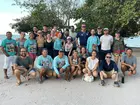
An Unforgettable Exploration of Sustainability on the Tapajós River
Puneet Chhabra ’24 reflects on Global Network Week at FGV Escola de Administração de Empresas de São Paulo, where he took a module on sustainable leadership.
Over the summer between their first and second years, MBA for Executives students at Yale SOM travel abroad to engage and challenge fellow students from other Global Network for Advanced Management member schools as a part of Global Network Week (GNW). While every GNW module and location was intriguing, I was eager to complement my rigorous course work with a once-in-a-lifetime experience that would ignite and motivate my career in sustainability. The one module that stood out from the rest was the “Sustainable Leadership: The Rainforest Perspective, Tapajós Expedition” offered by FGV Escola de Administração de Empresas de São Paulo FGV EAESP. The five-day GNW was a chance to escape the confines of the lecture hall and be fully present in one of the most ecologically important and sensitive biomes in the world. The objectives of the course were to learn the basics of sustainable development, meet the stakeholders in the Amazon River Basin, and cultivate one’s own sustainable leadership motivation and abilities. I was joined by three other Yale EMBA students, as well as students from the Stockholm School of Economics, Berkeley Haas, UCD Smurfitt School, and FGV EAESP.




The typical day on the Tapajós River was far from ordinary thanks to our guides Maurcio Halla, Leticia Artuso, and Ricardo Barretto. My classmates and I awoke in our hammocks to the sunrise and the sound of our boat’s engines. While we were getting ready and eating breakfast, the captain navigated us to a shoreline community where we would spend the morning. Upon arriving, we sat in a circle as the community leader explained the area’s history, social structure, and current struggles. Afterward we were shown the various economic activities that supported the residents and what changes they made over time to make their way of life more sustainable.
At midday we returned to our boat to escape the heat and enjoy lunch. Meals prepared by our onboard chef and restauranteur featured dishes typical of the Para region and often included cassava as a common ingredient. Juices and dessert were made of fruits only found in the Amazon. If time allowed, the boat moored on a sandbar, and we took a post-lunch swim in the river or tried our hand at fishing. In the afternoon we visited another village or research site and further explored the area, taking in the natural beauty of the forest and learning from the people who depend on it.
In the evening, we moored on another shoal for our evening bath in the river, being careful not to step on manta rays hidden in the sand. Dinner was often accompanied by capairinhas, a discussion of the day’s highlights, and what to expect the following day.
My expedition on the Tapajós River and through the Amazon forest illuminated some very notable issues affecting the area: Changes in political leadership have had a drastic impact on deforestation. Myopic goals of economic growth lose sight of the need for sustainability; many industries drive deforestation while needing the resources the forest provides. For example, cash crops like soybeans rely on the rains of the region that the forest is instrumental in creating. Recent studies suggest the Amazon dry season is getting longer.
NGOs are doing impactful work in the region, but they need consistent support from Brazilian and outside governments to protect a fragile ecosystem that is a significant carbon sink for the world. NGOs are also engaging with local communities and coalitions to empower local leaders. I observed that in most of the groups we visited, women led the sustainability and economic initiatives. In the Urucureá village, I saw how women led the Turiarte’s handicraft business. In the village of Vista Alegre do Capixauã, we saw how the Kumaruara people elected a woman as their kashiki, or community leader. These observations anecdotally mirror the significant female representation in chief sustainability officer) roles.
The aspect of the expedition that I loved the most was the time spent and connections made with my fellow travelers. The intensity of the journey and relatively small class size pushed us closer together. Plans are already in the works to have a reunion. As I begin the second year of my EMBA, I am taking the memories and experiences in the Amazon to propel me through my sustainability focused coursework.
